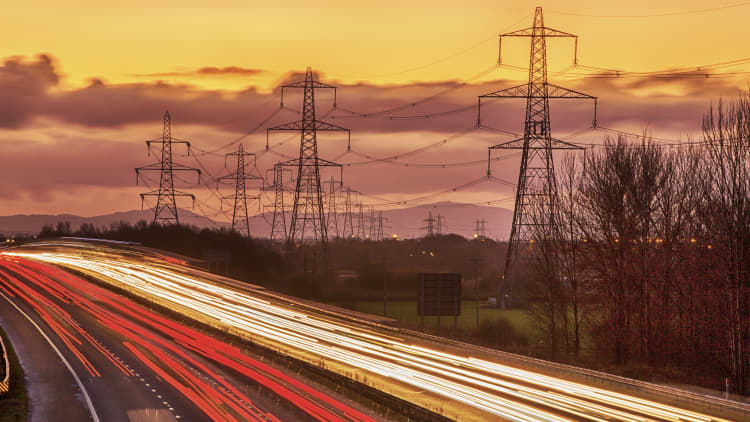The sun sets behind power transmission lines in Texas, the United States on July 11, 2022.
Nick Wagner | Xinhua News Agency | Getty Images
The Biden Administration is putting almost $3.5 billion into improving the strength and resiliency of the United States’ electric grid, government officials said on Wednesday.
The money is coming from the Bipartisan Infrastructure Law, which President Joe Biden signed in November 2021, and Wednesday’s announcement marks the first round of funding out of $10.5 billion that was allocated as part of the Grid Resilience and Innovation Partnerships (GRIP) Program to improve the nation’s electric grid.
The $3.46 billion announced Wednesday will go to 58 projects across 44 states, including some 400 microgrids across the country, the Department of Energy said.
The investments in the electric grid will get more than 35 gigawatts of clean energy onto the grid, the Department of Energy says. For some sense of perspective, a mid-size city needs a gigawatt of electricity, Microsoft co-founder and climate investor Bill Gates said in his book, “How to Avoid a Climate Disaster.”
The $3.46 billion in government funding announced Wednesday will be joined with $4.7 billion in investments from the private sector, bringing the total amount of catalyzed investment into the grid to $8.16 billion.
“Right now, the U.S. electric grid is the largest connected machine in the world. It’s 5.7 million miles of transmission and distribution with about 55,000 substations,” Jennifer M. Granholm, secretary of the U.S. department of energy, said on a conference call with reporters on Wednesday.
“And it needs upgrading, clearly,” Granholm said.
More than half of the transmission lines and power transformers were installed before 1970, Mitch Landrieu, White House Infrastructure Implementation Coordinator, told reporters on a conference call with reporters on Wednesday.
“Every time you turn on a light, charge your laptop, plug in an air conditioner or put leftovers in the fridge, you rely on the electric grid, and that grid has been in need of upgrade for a very, very long period of time,” Landrieu said.
And an old grid breaks down a lot, particularly in extreme weather events.
Service technicians work to install the foundation for a transmission tower at the CenterPoint Energy power plant on June 10, 2022 in Houston, Texas.
Brandon Bell | Getty Images News | Getty Images
“Our outdated grid is especially vulnerable to the increasing impacts of the climate crisis. Older equipment can overload during extreme heat and cold when power is needed most,” Landrieu said. “And it’s also more likely to fail when communities are washed out by historic floods, and decimated by stronger storms.”
Investing in the electric grid has direct impacts on the lives of people, Landrieu said.
“What exactly does that mean to the American people? It means that a grandfather in Arizona will be able to cool his home during deadly summer heat. A working mom in Georgia won’t have to worry about a fridge full of food and medicine spoiling and how to afford to replace it. A small business owner in North Carolina will not suffer power outages that cost her thousands of dollars in lost inventory,” Landrieu told reporters.
The program marking federal funding for upgrading the electric grid was popular — the Department of Energy received 700 concept papers or letters of interest from all over the country, a senior administration official told reporters. From there, 300 applications were encouraged to go on to the next stage of the application process and then 58 were ultimately selected.

As an example of one of the successful applications, Georgia will receive $507 million will to invest in battery storage, local microgrids, other investments in grid reliability and in new transmission lines.
In another example, 15 government entities, energy companies, and community and academic institutions in Louisiana will work together to improve emergency response in the state by building microgrids that can operate alone or serve back up for the electric grid.
In Oregon, the funding will improve transmission capacity so that 1,800 megawatts of solar capacity east of the Cascade Mountains, where it is currently not connected to customer demand, can get to utility customers. Also in Oregon, PacifiCorp will make improvements to its electric grid that will strengthen grid infrastructure against fires and floods.
Also, some of the $3.46 billion in funding will go towards multiple inter-regional transmission projects.
For example, funding will go towards coordinating five transmission projects that will go spread across Iowa, Kansas, Nebraska, North Dakota, Minnesota, Missouri, and South Dakota. This collection of projects, called the Joint Targeted Interconnection Queue Transmission Study Process and Portfolio, will use a coordinated and long-term interregional assessment process that will study many projects at once as opposed to one at a time.
In addition, 39 small, rural not-for-profit electric co-ops across Arizona, California, Colorado, Idaho, Kansas, Minnesota, Montana, Nebraska, New Mexico, North Dakota, Oklahoma, Oregon, South Dakota, Utah, Washington and Wyoming will get funding to make improvements and upgrades to their electric grids to make them more resilient to wildfire damage.
A report published Tuesday from the from the International Energy Agency showed that improving electricity transmission lines is not only a problem for the United States.
The world has to add or replace 49.7 million miles of transmission lines by 2040 in order for countries to meet their climate goals and to achieve energy security priorities, the IEA found in its report. That amount is roughly equivalent to the total number of miles of electric grid that currently exists in the world currently, according to the IEA. This remarkable scale up in the construction of transmission lines across the globe will require the annual investment in electric grids of more than $600 billion per year by 2030, which is double what current global investment levels are in transmission lines, the IEA says.

>>> Read full article>>>
Copyright for syndicated content belongs to the linked Source : CNBC – https://www.cnbc.com/2023/10/18/biden-administration-to-invest-3point5-billion-into-the-electric-grid.html































